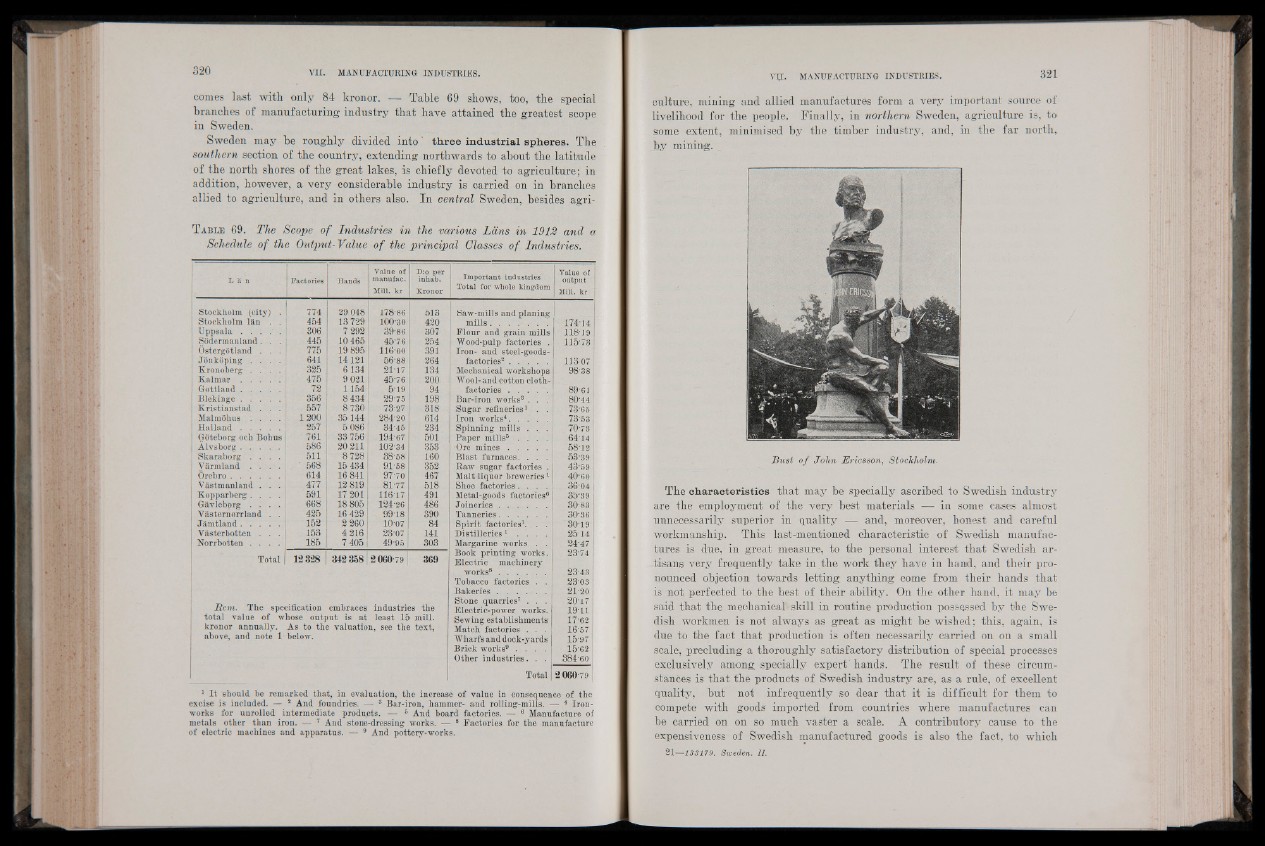
comes last with only 84 kronor. — Table 69 shows, too, the special
branches of manufacturing industry that have attained the greatest scope
in Sweden.
Sweden may be roughly divided into three industr ia l spheres. The
southern section of the country, extending northwards to about the latitude
of the north shores of the great lakes, is chiefly devoted to agriculture; in
addition, however, a very considerable industry is carried on in branches
allied to agriculture, and in others also. In central Sweden, besides agri-
T able 69. The Scope o f Industries in the various Làns in 1912 and a
Schedule of the Output- Value of the principal Classes of Industries.
L ä n Factories Hands
Value of
manufac.
Mill, kr
D:o per
inhab.
Kronor
Important industries-
Total for wLole kingdom
Value of
output
Mill, kr
I
Stockholm (city) . 774 29 048 178-86 513 Saw-mills and planing
Stockholm Ian . . 454 13 729 100-30 420 mills....................... 174-14
Uppsala . . . .' . 306 7 292 39-86 307 Flour and grain mills 118-19
Södermanland. . . 445 10465 45-76 254 Wood-pulp factories . 115-73
Östergötland . . . 775 19 895 116-00 391 Iron- and steel-goods-
Jönköping . . . . | 641 14121 56-88 264 factories2 . . . . . 113 07
Kronoberg . . . . | 325 6134 21-17 134 Mechanical workshops 98-38
K a lm a r ................ 475 9 021 45-76 200. Wool- and cotton cloth-
Gottland................ 72 1154 5-19 94 factories ................ 89-61
Blekinge................ 356 8 434 29-76 198 Bar-iron works3 . . . 80-44
Kristianstad . . . 557 8 730 73-27 318 Sugar refineries1 . . 73-65
Malmöhus . . . . 1200 35144 284-20 614 Iron works4............... 73-53
H a lla n d ................ 257 5 086 34"45 234 Spinning mills . . . 70-73
Göteborg och Bohus 761 33 756 194-67 501 Paper mills5 . . . . 6414
Älvsborg................ 586 20 211 102-34 353 Ore m in e s ................ 58-12
Skaxaborg . . . . 511 8 728 38-58 160 Blast furnaces. . . . 53-39
Värmland . . . . * 568 15 434 91-58 352 Raw sugar factories . 43-59
Örebro . . . . . . 614 16 841 97-70 467 Malt liquor breweries1 40-60
Västm anland . . . i 477 12 819 81'77 - 518 Shoe factories. . . . 36'04
Kopparberg. . . . 591 17 201 116-17 491 Metal-goods factories6 35-39
Gävlebprg . . . . 668 18805 124-26 486 Joineries................... 3083
Västernorrland . . j 425 16 429 99-18 390 Tanneries................... 30-36
Jämtland.................| 152 2 260 1007 84 Spirit factories1. . . 30-19
Yästerbotten . . . 1 153 4216 2307 141 Distilleries1 . . . . 2514
Norrbotten . . . . | 185 7 405 49-65 303 Margarine works . . 24-47
Book printing works. Totall 12328 342 358 2374 2060 79 369 Electric machinery
works8 ................... 23-43
Tobacco factories . . 2303
Bakeries.................... 21-20
Rem. The specification embraces industries the
Stone quarries7 . . .
Electric-power works.
20-17
total value of whose output 1911 is at least 15 mill. Sewing establishments 17-62
kronor annually. As to the valuation, see the text, Match factories . . . 16-57
above, and note 1 below. Wharfs and dock-yards 15-97
Brick works9 . . . . 15-62
Other industries. . . 384-60
' ] Total 2 060 79
1 I t should be remarked that, in evaluation, the increase of value in consequence of the
excise is included. — 2 And foundries. — 3 Bar-iron, hammer- and rolling-mills. — 4 Ironworks
for unrolled intermediate products. — 8 And board factories. — 6 Manufacture of
metals other than iron. — 7 And stone-dressing works. — 8 Factories for the manufacture
of electric machines and apparatus. — 9 And pottery-works.
culture, mining and allied manufactures form a very important source of
livelihood for the people. Finally, in northern Sweden, agriculture is, to
some extent, minimised by the timber industry, and, in the far north,
by mining. J
B u st o f John Ericsson, Stockholm.
The characteristics that may be specially ascribed to Swedish industry
are the employment of the very best materials — in some cases almost
unnecessarily superior in quality — and, moreover, honest and careful
workmanship. This last-mentioned characteristic of Swedish manufactures
is due, in great measure, to the personal interest that Swedish artisans
very frequently take in.the work they have in hand, and their pronounced
objection towards letting, anything come from their hands that
is not perfected to the best of their ability. On the other hand, it may be
said that the mechanical skill in routine production possessed by the Swedish
workmen is not always as great as might be wished; this, again, is
due to the fact that production is often necessarily carried on on a small
scale, precluding a thoroughly satisfactory distribution of special processes
exclusively among specially expert hands. The result of these circumstances
is that the products of Swedish industry are, as a rule, of excellent
quality, but not infrequently so dear that it is difficult for them to
compete with goods imported from countries where manufactures can
be carried on on so much vaster a scale. A contributory cause to the
expensiveness of Swedish manufactured goods is also the fact, to which
21—133179. Sweden. II.